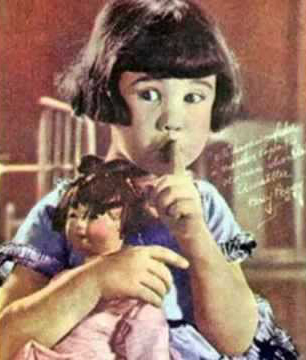
 |
|
|
|
Most any mention of child star actors from earlier decades leads to tragic stories about the hard lives many have had to lead. Some were treated as a source of income by venal showbiz parents, and cruelly exploited. Robbed of anything resembling a normal childhood, others found themselves unprepared to make wise personal decisions when their show-biz days were over. The most famous story is that of Jackie Coogan, the little star of Chaplin's The Kid, whose hard-earned millions were stolen by his own relatives. In 1939 the State of California passed the Coogan Act to see that at least some of the money earned by child stars was kept in trust for them, when they became too old to play cute moppets. 
Baby Peggy: The Elephant in the Room tells the amazing story of a once-famous, high-earning child star whose career spanned only about five years, from 1921 to 1926. Dutch-born filmmaker Vera Iwerebor had been collecting information on Baby Peggy for years, and finally contacted her in person. Lucid and candid about her experience, Peggy (now known as Diana Serra Carey) could document her entire story, as she'd kept a secret photo scrapbook. Iwerebor helped round up surviving Baby Peggy short subjects from film archives around the world. Peggy's story is a jaw-dropper. While under two years of age, it was discovered that she was a natural mimic and performer, and sufficiently attentive to take complex direction for the camera. Peggy immediately became a hit in a never-ending stream of comedy short subjects. Her family situation was not ideal: her father was not progressing as a screen cowboy and extra, and quickly saw the potential in a daughter who earned serious money as a film star. Peggy's older sister was pretty much pushed aside while Peggy received all the attention. Anecdotes and photos of the girls set up a potentially poisonous Baby Jane & Blanche Hudson conflict, which thankfully never happens. 
What did happen was criminal enough. While Peggy worked full weeks from age 2 to 7, she never attended school. Her image was heavily merchandized; we see the products bearing her name. Her father spent her money lavishly, buying things like a Duesenberg automobile. Peggy's mother, a film extra, had little control over anything. Peggy made hundreds of popular shorts and was getting into longer-form stories when an argument between her father and mogul Sol Lesser locked her out of the studio and brought her career to an unexpected sudden stop at the ripe age of seven. At that point she was put on the vaudeville circuit, playing multiple shows a day. But the money she earned crisscrossing the country was all stolen by a business manager -- many thousands of dollars that if adjusted for inflation represented millions. Only nine or ten years old, Baby Peggy's work and talent had supported the family for years, but she was still a child with no right to question anything. The now-failed Baby Peggy image was "the elephant in the room" that ruined any hope of domestic normalcy. The family eventually broke up. Peggy played in a couple more pictures as Peggy Montgomery and then appeared unbilled in several pictures until she made her last in 1938. Interestingly, the moment she left show business behind, her life took a major turn for the better. Working in a Catholic bookshop, she changed her name to Serra, after Father Serra of the California missions. She married an artist, and together they lived in Mexico, creating greeting cards. She wrote books about Hollywood and the histories of other child actors, and became an activist for further Child Protection laws for the entertainment industry. The finish of the film sees "Baby Peggy" an elderly but sharp-minded and still attractive woman, independent and in control of her life, with a granddaughter to talk to and many accomplishments to be proud of. |
|||||||||||||||||||
Review Staff | About DVD Talk | Newsletter Subscribe | Join DVD Talk Forum
Copyright © MH Sub I, LLC dba Internet Brands. | Privacy Policy
Subscribe to DVDTalk's Newsletters
|